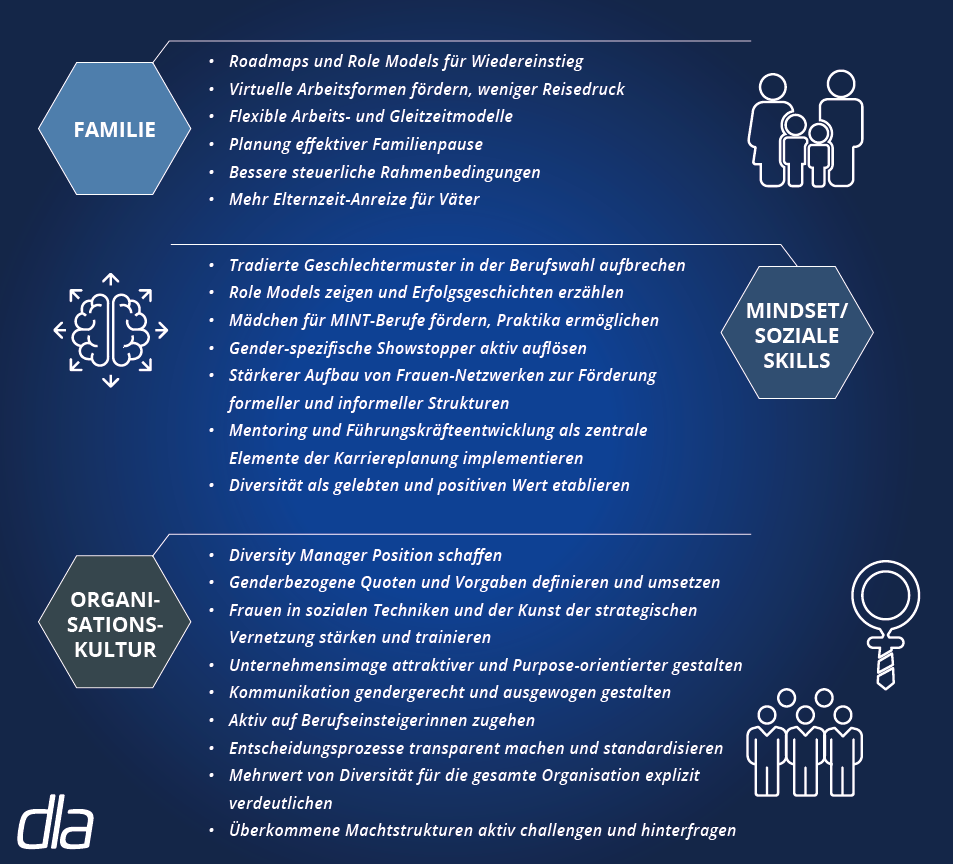
Career Paths of Women in STEM Professions
A Study by dla Digital Leaders Advisory
Gender-diverse teams are better. They make faster and better decisions, are more creative, resilient in stressful situations, more motivated, and attractive to new talent. This fact has been confirmed by numerous studies and reports. However, women are still significantly underrepresented in leadership teams, despite an increasing number of successful female high school and university graduates. Only just under one-third of executives are female today, and in STEM professions, the proportion is not even ten percent. The German-Swedish AllBright Foundation, advocating for more diversity in top business positions, notes in its latest report that only seven percent of executive positions in the 100 largest German family businesses are held by women. And among the 160 companies listed on the Frankfurt Stock Exchange, the percentage of female board members is only ten percent.
Reasons
The reasons for this situation have been extensively researched. Key obstacles include long-established power structures and networks formed over decades (if not centuries), as well as family-related interruptions that often do not lead to a return to an equivalent position. Furthermore, the percentage of women in STEM study programs is still disproportionately low, resulting in a lack of female successors for leadership positions.
Solutions
What could solutions look like? The legislator has established a binding framework with the Second Management Positions Act (FüPoG II) to bring more women into the boards of large companies. At the same time, there is growing societal pressure on companies to break up their homogeneous structures and ensure conditions for equal female careers. However, these instruments can only be effective if a cultural shift is initiated, and existing patterns are critically questioned and consciously changed.
Stage is Set
Above all, it is essential to talk less about women in leadership positions – and more with them. Therefore, the initiator of the study, Barbara Apergis from dla Digital Leaders Advisory, conducted in-depth interviews with some exceptionally successful women in STEM fields, gathering valuable insights into their success recipes, decisions, and overcome challenges. The interviewees come from IT consulting, information technology, machinery and plant engineering, and software development, with some holding leading positions in AI (Artificial Intelligence), data science, R&D, and digital innovation.
“Advancing in a career is a bit like mountain climbing,” one of our interviewees expressed. “At first, you walk comfortably, then you go higher and enjoy the view. When you reach the snow boundary, the world suddenly changes: you need a rope team, crampons, and a safety net.” A fitting comparison, as the history of mountaineering was long a narrative where women were on the mountain but not in the books. Time to change that.
WHY MINT | Technology has no gender
“Who will build the future if not us?”
Women choosing a STEM profession don’t do it because of institutional support – quite the opposite. Educational institutions and other organizations still convey typical career patterns and often direct young women into “typically female” fields like language and social sciences. Almost always, close family members serve as role models and supporters on the way to a STEM profession.
“My parents are scientists…”
“Thanks to my father, I had a great technical understanding from an early age…”
“My father also studied electrical engineering…”
“I taught myself programming early on – my father supported that…”
Those who consciously choose a different path have more in mind than status and income. Because those are easier to attain. And so, the interviewees consistently report a desire to contribute to their profession’s meaningful and beneficial aspects. This involves, on the one hand, the opportunity to shape the future, utilize technology and research potentials for positive transformation.
“Through technology, people connect and communicate better.
It motivates me to contribute to that…”
“IT will play a central role in shaping the future. Being part of that is very inspiring…”
“Using technology to do something good, to create value –
I gladly get up for that every day…”
“I want to make a difference, change the world…”
“I want to take an active role so that the future doesn’t overwhelm us,
but that we can shape it…”
“Knowing that I can move things for the better gives me satisfaction…”
On the other hand, the desire for shaping also extends to the social environment – the development of teams through coaching, empowerment, and encouragement, and intensive, exciting, and motivating communication within a social ecosystem.
“Empowering and developing my team motivates me a lot…”
“I see myself as a translator: technical products are complex and barely tangible,
they need to be translated – by someone who speaks both languages…”
An essential part of this communication is a specific translation service – placing technological topics into a societal context and clarifying the benefits technology can provide for central issues.
WAY TO THE TOP | The Heroine’s journey„Who wil build the future if not us?“
„A little more Machiavelli would often do us women good.“
Reflecting on their experiences, the interviewees emphasize that opening STEM professions to women needs to begin early in education and consistently continue through all educational steps – with more application-oriented approaches, early internship opportunities, and improved didactics.
Rethinking Education
Successful role models play a central role during the educational journey – it is crucial to make the stories of successful women careers in “hard” subjects tangible to create a positive pull effect. The interviewees wish for a more active involvement of media and industry in direct communication with female students, reporting on successful women in STEM professions, and changing the dry and gender-imbalanced image of technology companies.
Technology and digitization are more than ever the driving forces of societal, ecological, and economic transformation. The opportunities arising from active, participatory involvement in this process must be presented as attractive educational and career paths that should not be closed to women.
“We need to start as early as possible: in kindergarten and primary schools…”
“Long-term orientation measures are needed in schools…”
“Early mentors and role models are needed to inspire young women…”
“Girls should get their hands on technology early and see
the amazing careers they can have in the technology industry…”
Changing Structures
However, successfully entering a STEM profession does not guarantee equal career opportunities. The fact that women still rarely reach management positions is, according to the interviewees, not primarily due to a lack of talent but to the conservative and family-unfriendly structures still prevalent in leadership roles. Additionally, there is an issue described by Sheryl Sandberg as “Don’t leave before you leave!” Women often step back long before starting a family, rejecting management tasks in anticipation of their career breaks. Greater flexibility, hybrid presence models, and reducing travel requirements could play a significant positive role – they have already passed the practical test in the COVID-19 crisis. Especially when children are still young and intensive traveling for mothers is hardly feasible, this could provide significant relief.
Another central factor is the structural disadvantage that hinders women in building internal networks, mentoring structures, and coalitions.
“More women would support more women – critical mass has not been reached yet…”
“Women also need mentors who push them… without them, it’s hard to move up…”
“Advancing in a career is a bit like mountain climbing. Above the snow boundary, the world suddenly changes:
you need a rope team, crampons, and a safety net…”
As the interviewees emphasize, reaching a certain hierarchical altitude often requires strategic networking. However, women lack both potential female mentors and network partners at the top levels. Furthermore, strategic networking, mutual support on the way up, and creating majorities are learned and habituated strategies. However, these strategies have hardly been part of the female “educational canon” so far. The interviewees unanimously stress that it is urgently necessary for women to learn the art of strategic networking.
Becoming Self-Confident
However, knowledge of corporate political contexts and the ability to use strategic tools on the career path are not enough. It takes the will to use them. And that includes advocating for oneself. Good work alone does not speak for itself. Confident, goal-oriented behavior is necessary – traits that, according to the interviewees, women often struggle with. It requires self-assurance and courage to show edges and corners, to demand things, and not primarily aim for harmony.
“We urgently need to support girls’ self-assessment.”
“Men dare to show edges and corners – they are tangible, and you know what they stand for, while women tend to try to please everyone…”
“Women often stand in their own way: first, they don’t know what they want…
then they don’t say what they want…”
“Women need to understand how the game works. More Machiavellian traits would do women good…”
However, the study participants also emphasize that women often face systemic barriers: Promotions heavily follow an intuitive conformity pressure, favoring those who resemble the supervisors the most – the now scientifically clear “Mini-Me” or “Thomas Principle.” Therefore, it is urgently necessary to objectify promotion mechanisms and processes and make decision criteria transparent.
“Women need to learn a foreign language in the male-dominated workplace…”
“Many leaders strive for maximum smoothness, resulting in great one-sidedness in the result…”
“Men hire men who resemble them, even in name…”
Culture of Diversity
However, corresponding changes and initiatives in companies will only be successful if they are supported by a corresponding culture. The question is: Will the necessary changes for women’s progress be understood, accepted, and perceived as indispensable and valuable on a broad front?
Here, the interviewees have significant doubts. Learned behavior, traditional thought patterns, and a lack of ability to change perspectives complicate cultural change. Breaking existing informal mechanisms and behavioral patterns and opening up networks require, beforehand, intensive and critical reflection on one’s own values, role, and the effects of one’s decisions, especially among male colleagues. And last but not least, it also involves a loss of status and power, as the study participants emphasize. This often leads to diversity being degraded to a lip service. Therefore, it is crucial to accompany cultural change not only through active communication and vision production but also through systemic measures. These include company-specific and generally binding quotas and requirements, as well as creating transparent processes and regulatory positions such as that of a diversity manager
“Diversity topics often revolve mainly around reputation…”
“Diversity is something for the powerful to feel better…”
“Not everywhere diversity is labeled is diversity inside…”
GET BETTER | On the way to a culture of equal opportunities
“We must break prehistoric gender roles.”
The study has shown that traditional, “prehistoric” patterns are still prevalent in STEM professions, responsible for not fully tapping into the potential of dedicated and talented women. However, this potential is only one side of the coin. Equally important is the question of what companies should look like where we want to work in the future. If the vision of an organization becoming a reality, characterized by diversity, openness, fairness, and creativity, offering opportunities that do not penalize starting a family and do not reward clandestine intrigues, then there is still much to be done. Then it is necessary to tackle a transformation task that requires change on several dimensions. The study participants have shown these dimensions. Everyone is needed – societal institutions, educational institutions, families, companies, and of course, women themselves. Let’s tackle it!

Starting point for more equity in leadership positions
